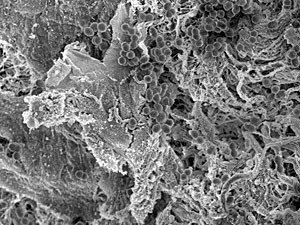Researchers take a key step in the fight against antibiotic-resistant bacteria

MINNEAPOLIS / ST. PAUL (06/28/2011) – A University of Minnesota-led team of researchers has discovered how a genetic "switch" controls the spread of antibiotic resistance in certain pathogenic bacteria. The discovery points the way toward developing a means of keeping the switch "off" in order to thwart the spread of resistance, a growing threat to global health and lives. The study was recently published in the Proceedings of the National Academy of Sciences.
The team of chemical engineers in the University's College of Science and Engineering's and and microbiologists in the Medical School studied genes that regulate the transfer of antibiotic resistance from one individual to another in the bacterial species Enterococcus faecalis.
"For the past 20 years, it's been an increasing cause of hospital infections," says microbiology graduate student Christopher Johnson, who took part in the research. "It gets on heart valves and implanted devices."
"It's possible that if you found a molecule that targeted this switch and kept it in the 'off' position, it would be toxic to bacteria in combination with an antibiotic," says co-author and microbiology professor Gary Dunny.
Many components of the switch were already known, "but this is the first time anyone has connected the dots," says chemical engineering graduate student Anushree Chatterjee, the first author on the paper. "[In experiments] I added various components of the system and showed how they worked together and that all were needed for the switch to work."
Battle of the genes
Genes for antibiotic resistance are carried in circular pieces of DNA called plasmids. A bacterial cell that has a plasmid can pass it, resistance genes and all, to a cell that doesn't through a bacterial mating process called conjugation.
The genetic switch involves interplay between two genes—Q and X—that lie opposite each other, one on either strand of the DNA double helix of a plasmid. The whole purpose of the switch is to control Q. When active (switch-on mode), Q induces the cell to conjugate and share a copy of the plasmid.
In the plasmid in question, the Q and X genes are normally both being "read." When a gene is read, a large protein moves along a DNA strand and, guided by information in the DNA, constructs a strand of RNA; this RNA is the actual "message" that tells the cell what to do. Multiple copies of the large protein glide along the Q and X genes simultaneously but in opposite directions, each protein carrying with it a growing strand of Q RNA or X RNA.
Here's how the switch that controls the Q gene is kept off:
Normally, as the proteins move down the DNA strands, they collide like two wide trains trying to get by each other on tracks spaced too closely together. The collisions knock the proteins and the growing chains of RNA off the DNA "tracks." Thus, only rarely is a complete RNA of either type made.
If a complete Q RNA should squeak through, all it takes is a small piece of X RNA to attach to it and inactivate it. Thus, X RNA fragments are a backup to the "collision" control method.
Switching on the conjugation gene
A kindred bacterial cell that lacks a plasmid will continually release a pheromone that can penetrate any nearby plasmid-bearing cell. Once inside, the pheromone causes extra proteins to read the Q gene, and soon the number of completed Q RNA strands swamps even the backup system. These strands then instruct the cell to conjugate and pass the plasmid—and the antibiotic resistance genes it carries—to the kindred bacterial cell.
Armed with this knowledge of how the spread of antibiotic resistance is controlled, scientists have a better hope of finding ways to thwart it.
The bacterial point of view
"Because conjugation is an energy-intensive process, the plasmid donor cells must turn their conjugation system on only in response to a true signal—the pheromone," explains Wei-Shou Hu, a professor of chemical engineering and materials science and corresponding author of the paper. "A switch type of regulatory mechanism allows for a tighter control of conjugation."
Why should bacteria want to conjugate at all? "This kind of mechanism allows bacterial species to carry a huge number of genes [on various plasmids] without every cell having to," says Johnson.
Also, sharing plasmids that confer antibiotic resistance may be a strategic move when bacterial numbers are small and many of them lack the plasmids, the researchers say. By conjugating, they fortify each other with resistance genes before they multiply in earnest; this ensures that they will resist an antibiotic after their numbers have grown and they've made their host sick enough to seek drug treatment.
To read the researchers' full paper, visit http://z.umn.edu/bacteria.
